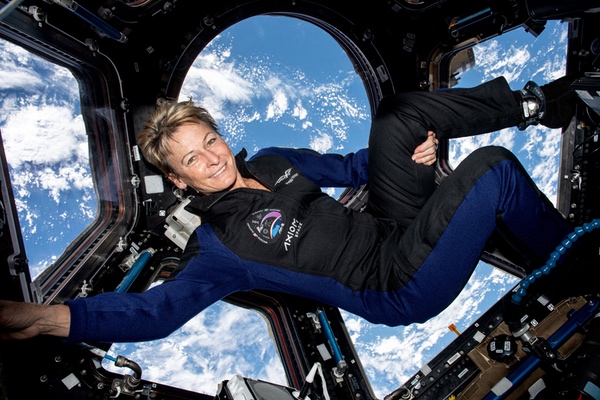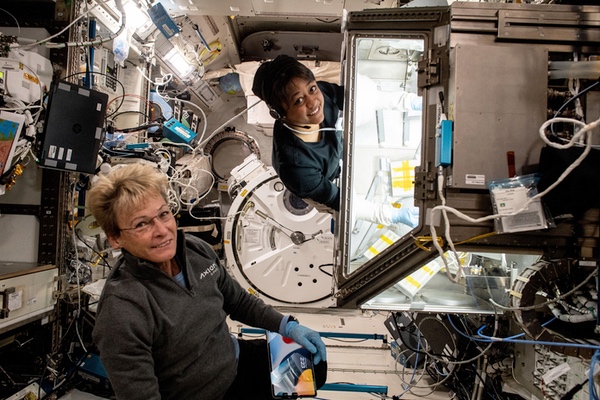 Peggy Whitson spent 665 days in space on three long-duration ISS missions before a much shorter visit in May commanding the Ax-2 private astronaut mission. (credit: Axiom Space) |
A veteran astronaut adjusts to a new era of private spaceflight
by Jeff Foust
Monday, June 26, 2023
Peggy Whitson is America’s most experienced astronaut, having spent 665 days in space on three long-duration missions to the International Space Station in 2002, 2008, and 2016–2017. But returning to the station as a private astronaut, commanding Axiom Space’s Ax-2 mission in May, still required some adjustments.
“The short time was the harder part,” she said of the mission, which spent eight days docked to the ISS, during an interview a couple weeks after splashing down in a Crew Dragon spacecraft with her three crewmates May 30.
| “The big change really is to go back to short-duration missions, more like a shuttle flight,” she said of training for Ax-2. |
“When you go up on a long- duration mission you are thinking, I’ve got time, I can relax now, because I can scale up and start moving later and getting more and more done,” she explained. “But we didn’t have that flexibility. It was very much a focused effort.”
Ax-2 was Axiom’s second in a series of private astronaut missions to the station as the company develops commercial modules to install on the station later this decade, which will later form the core of a standalone commercial station. Ax-1, which went to the station in April 2022, was something of a learning experience for both the company and the agency, particularly in how to schedule all the experiments and outreach activities the crew wanted to achieve.
One of the biggest lessons was optimizing the training for the mission. “The big change really is to go back to short-duration missions, more like a shuttle flight,” she said. “Instead of generic skills training, which is typically how we train a station crew, we were much more task oriented. So, we focused on the tasks we knew we would do and the hardware we knew we’d interface with. That made our crew ready to respond and ready to perform once they got on orbit.”
While Ax-1 got some schedule relief when its ten-day mission was extended a week while waiting for favorable splashdown conditions, Ax-2 had its mission shortened from ten to eight days because of the cascading effects of launch delays and a desire by NASA to keep a cargo Dragon mission on schedule for launch in early June.
“It was a compressed schedule,” she said, but the focus on specific training helped accommodate that time, along with keeping her schedule open in the early days of the mission to assist her crewmates, helped. “I think it was very effective.”
Whitson had been training with John Shoffner, a private astronaut who served as pilot of Ax-2, since 2021, when the two were named as backups for Ax-1. Shoffner used that time to get extra training on ISS systems, including getting a specialist rating—the highest NASA qualification—on station maintenance. “He wanted more of the experience of what it is like to train as a NASA astronaut,” she said, “so we were able to get him that extra training.”
They started training with the other two Ax-2 crew, Saudi astronauts Ali Alqarni and Rayyanah Barnawi, in September. In addition to various training on ISS and Crew Dragon systems, they also did an exercise with the National Outdoor Leadership School, learning what she called “expeditionary skills” in the wilderness, and spent time in the Human Exploration Research Analog (HERA), a simulated space habitat at the Johnson Space Center.
 Peggy Whitson and Rayyanah Barnawi doing research on the ISS during Ax-2. (credit: Axiom Space) |
The training overall went well, Whitson said, and her crewmates adapted well to the station and the research programs. She singled out Barnawi, a cancer researcher, for her dedication to doing experiments in a “glovebox” on the station, spending so much time that others were worried about her.
“I go check on her and I’m like, ‘Everybody’s really worried about you and I want to know how you are feeling about being in here?’ She’s loving it,” she recalled. “I’m basically having to fight her to get her out of there so I could get in there.”
| “It was a lot of fun to fly on a new vehicle,” she said. “The Falcon 9 and the Dragon was a sweet ride.” |
There are lessons learned and other adjustments to training she wants to incorporate on future Axiom missions to the station. “I want to try and so some more intensive mission-specific training,” she said. The five days the Ax-2 crew spent in HERA was particularly useful, she said, given them experience in a simulated space environment, including learning how to work to a timeline and communicate with controllers.
Visiting the ISS as a private astronaut for the first time, after extended stays as a NASA astronaut, was not as big a change for Whitson as the short mission duration. She compared it to visiting shuttle crews during her earlier long-duration stays there. “It felt familiar in that sense. I was just in the other the other side of it. I was the visiting crew rather than the resident crew.”
The Ax-2 crew got along well with the long-duration station crew. Whitson said they had not gotten a chance to meet with NASA’s Frank Rubio and Roscosmos’ Sergey Prokopyev and Dmitri Petelin before the flight, since the three had been scheduled to return in March before Ax-2. A coolant leak in their Soyuz spacecraft, though, prompted the launch of a replacement that had been intended for the next crew, keeping the three of them on the station until September. “Frank’s an amazing leader and they all have a pretty good attitude about being there an extra six months,” she said.
Whitson, who previously went to the station on shuttle and Soyuz vehicles, enjoying flying Crew Dragon. “It was a lot of fun to fly on a new vehicle,” she said. “The Falcon 9 and the Dragon was a sweet ride.”
A highlight of the Crew Dragon is the touchscreen interface. “It’s very integrated with procedures and data. It feels like you’re very situationally aware as you’re going through the steps and performing actions,” she said. “I find it’s a great interface, much more operator friendly, user friendly for the astronauts.”
Splashing down in the ocean, she added, was also better than the Soyuz landings. “But the shuttle landings on runways is the best way to come home.”
| “Now I think we’ve demonstrated that we’ve got this,” she said. |
Whitson estimated that Axiom incorporated about 80% of the lessons learned from Ax-1 into Ax-2, with the remaining 20% to be worked into Ax-3, currently scheduled for no earlier than late this year. Axiom has not announced the crew for that mission but, during the webcast of the Ax-2 splashdown, the hosts said that Michael López-Alegría, who commanded Ax-1, would lead Ax-3.
Those training plans will shift again the coming years as Axiom gets its modules installed on the ISS—the first is scheduled for launch as soon as late 2025—and goes towards longer missions. “But I think that to make us successful now we need to really push back toward that short mission and optimize it,” she argued.
“Now I think we’ve demonstrated that we’ve got this,” she said. “The next phase is going to be the continuation and expansion of this.”
No comments:
Post a Comment